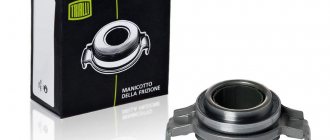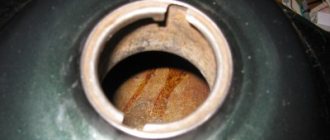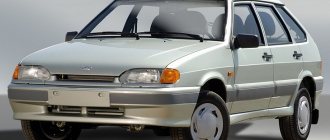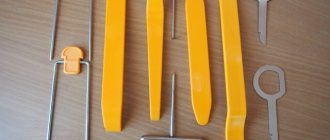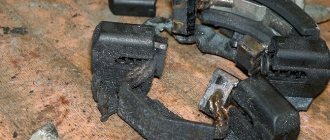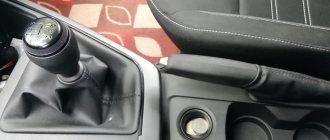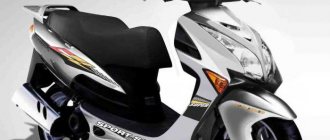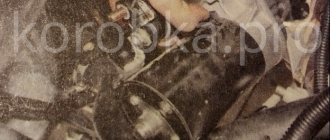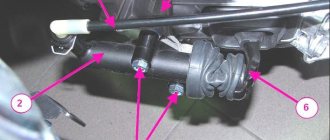The gearbox is the main unit after the engine. The Priora manual transmission is a reliable, modernized unit from 2110. The Priora's mechanics are filled with 3 to 3.5 liters of oil. Russian cars are chosen for their relative reliability, cheap spare parts, and endurance. If we take the manual transmission, then this is a reliable, unpretentious unit - although the box howls in 2nd gear, even when the car is new. The sales leader from 2012 to 2021 was the Lada Priora, especially in the Caucasus and CIS countries. It is well equipped and has decent technical characteristics. Since 2014, it has been possible to find cars equipped with an automatic transmission. The weakest Priora engine has a power of 87 horsepower, depending on the body type. The initial configuration of the Priora is a 1.6-liter eight-valve engine. It is equipped with a manual transmission.
Characteristics of the Lada Priora gearbox
The base of the gearbox is represented by the following units:
- Clutch housing;
- Transmission housing;
- Rear transmission starter flap.
All elements are connected to each other with fixing nuts and sealant. The design is protected from contamination by means of a magnet that retains waste metal products. The main shaft is a set of gears that, when rotated, are connected to additional gears of all speed modes. The additional shaft is designed to regulate and distribute the oil emulsion.
There are two types of bearings installed on the gearbox shafts: ball bearings in front, roller bearings in the rear. In order to connect with the outside atmosphere, a breather is provided. It is located at the top of the node.
The AvtoVAZ model has two types of transmission: controlled by traction or cables. The mechanism of action and design of both options are radically different from each other.
Made with German precision
When this concept was transferred from paper to a real exhibit, and the mechanism began to work correctly, the module went to Germany, to. The Germans brought the knot to fruition. The company has long been developing various transmission systems and manufacturing engines. German experts carefully looked at the development of Russian engineers and proposed the following. Using a 3D center plate instead of a locking spring return system would make more sense. The special spatial shape of this plate was calculated using computer programs and manufactured using high-precision equipment. This accuracy is due to the fact that a special locking ball moves along the plate. And it is the plate that regulates the effort when selecting and engaging gears. The characteristics that the new cable gearbox will have were selected using a simulation stand. The man sat down on a chair and switched on various gears. Automatic systems simulate shift patterns, lever forces and strokes. And just like that, in small steps, the Germans managed to find the optimal settings. With the help of a computer, parameters and a mathematical model were selected, according to which these plates would then be manufactured.
All the details of the box - what's inside
The five-speed gearbox of the Lada Priora is connected to the central gear and differential. The Priora gearbox consists of shafts: the input shaft is made as a block of central gears. The gears of the forward speed modes have oblique teeth, the reverse gears have straight teeth. They contact the gears of the secondary shaft. There is an oil sump at the bottom of the secondary shaft in the bearing area. It is responsible for distributing the oil emulsion and supplying it to the secondary shaft, and then to the driven gears of all gears. The design of the gearbox includes a gear synchronizer. Synchronizers for 3rd, 4th, 5th gears have a similar design. The only difference is the blocking circles. The parts of 1st and 2nd gears have a different design. They have two cone-shaped friction areas installed, which relieve the load, distributing it evenly among themselves.
There is a magnet in the core of the clutch housing. It attracts metal waste and shavings and prevents its penetration into the system. A mandatory element of the box is the drive. It should be treated with special care. In addition to the listed parts of the box, it contains a jet rod, which is fixed at one end to the motor. Thanks to this, independent gear changes while driving are excluded.
The traction-controlled transmission has a three-arm handrail that activates the selected speed mode. A cable-operated transmission has a cable that activates the desired gear.
Installation of a cable-driven gearbox
The installation process is fraught with some difficulties, but there is nothing supernatural here. It is important to assemble a complete set of all parts and components. Holes should be made in the engine shield through which the cables will pass. From the engine compartment, this location is located next to the steering rack heat shield. Everything inside the car will fit without any modifications. On some models you will need to lower the electronic control unit. It is also necessary to cut the tunnel a little. Do not bend the cables during installation. The upper part between the engine and the clutch housing will fit perfectly, but the lower part will have to be modified. You can take it from an ordinary box. For those who do not know how to install a manual transmission with a cable drive, it is better to order this service at a service station.
Lada Priora gearbox malfunctions and ways to eliminate them
Like any car component, the gearbox is subject to the negative effects of external destructive factors. The Lada Priora gearbox can also break down. The nature and frequency of breakdowns is influenced by management style, operating conditions, timeliness of maintenance, and quality of care. The manufacturer recommends changing the lubricant every 60,000 - 70,000 kilometers. The quality and correct choice of substance also affect the service life. Conventionally, all problems with a node are usually divided into two large categories: problems with the node itself or its mechanism.
The main types of faults are shown in the table:
| Problems with the node itself | Mechanism problems |
| Gear wear | Drive rod malfunction |
| Failure of synchronizer clutches | The rod does not function, there is play |
| Spline message | Damage to the locking device |
| Reduced oil level | Roller wear |
| Liquid leak | |
| Bearing wear | |
| Deformation of oil seals | |
| Wear of the gearbox cushion |
There are a number of main reasons contributing to the breakdown.
Gearbox repair, the procedure for assembling and disassembling the Lada 2172 gearbox, the procedure for replacing oil seals in the Lada 2171 car gearbox, the stages of removing and installing the Lada Priora clutch discs. Maintenance and repair of the VAZ 2170 Priora transmission. Wheel drive VAZ 2172 Priora. Replacing the clutch of a VAZ 2171 Priora.
Warning If during the repair of the gearbox at least one of the following parts was replaced: clutch or gearbox housing, differential housing or differential bearings, then it is necessary to select an adjusting ring for the differential bearings.
You will need: a socket wrench (head) “10”, “13”, “32”, wrenches “10” and “17”, a large screwdriver, a bit, a hammer, pliers for removing the retaining rings, an impact screwdriver. 1. Remove the gearbox from the car (see “Removing and installing the priora gearbox”). Clean it from dirt and wash the outside. 2. Remove the oil level indicator (dipstick) from the gearbox. 3. Install the gearbox on the Lada Priora clutch housing vertically, using a 10mm wrench, unscrew bolt 1 (a flat washer is installed under its head) and two nuts 3 (spring washers are installed under them) securing the clutch cable bracket. Remove the clutch cable bracket 2 from the gearbox. 4. Using a 10mm wrench, unscrew the remaining four nuts securing the rear cover. 5. Using a screwdriver, pry off the boss on the cover and remove the back cover. 6. Using a 10mm wrench, unscrew the bolt securing the 5th gear fork (a spring washer is installed under the bolt head). 7. Secure the gearbox shafts from turning. To do this, engage 5th gear by moving the VAZ 2170 synchronizer clutch down along with the fork so that the coupling splines engage with the gear, then engage 3rd or 4th gear by moving the gear selection rod.
8. Unlock and use a 32mm head to unscrew the nut securing the VAZ 2171 input shaft. To do this, you need to apply a lot of force, since the nut is tightened with a large torque. 9. Having previously unlocked it, use a 32mm head to unscrew the nut securing the secondary shaft of the VAZ 2172. To do this, you need to apply force, since the nut is tightened with a large torque.
10. Using screwdrivers, lift the driven gear V of the Priora fret (thereby pressing the synchronizer hub from the shaft), remove it together with the synchronizer and fork from the secondary shaft. Warning Make sure that the synchronizer clutch does not come off the hub, as the spring-loaded synchronizer retaining balls may fall apart.
11. Remove the thrust plate from the synchronizer. Then remove the fork from the groove of the synchronizer clutch. 12. Remove the V gear from the synchronizer with blocking ring 1. Mark blocking ring 1 relative to clutch 2 and remove it. During operation, the teeth of the ring are worn in to the teeth of the coupling, so during assembly the ring must be installed in the same position. If you do not intend to disassemble the synchronizer of the Priora fret, tie it with wire or rope so that it does not fall apart.
13. Remove the bushing from the secondary shaft. 14. Remove the drive gear from the Priora input shaft. Pay attention to how it is installed. 15. Using an impact screwdriver, remove the four screws (there are spring washers underneath) securing the bearing plate and remove bearing plate 1. Then remove thrust washer 2 from the secondary shaft. 16. Remove the retaining rings from the bearings of both shafts by lifting the shafts by hand. 17. Using a 13mm wrench, unscrew the three locking plugs and carefully remove the locking balls with springs. 18. After unscrewing the Lada Priora reverse lock plug, remove the O-ring, and then remove the lock spring. 19. Tilt the box and remove the locking ball. 20. Unscrew twelve nuts and remove the bolt securing the Lada Priora gearbox housings. Pay attention to which nuts the holder 1 and the transport eye 2 are installed under. Spring washers are installed under the nuts and bolt. Remove plug 3 inserted in place of one of the drives. 21. By inserting a screwdriver into the grooves (three special grooves along the perimeter of the crankcases), separate the gearbox housing from the clutch housing. 22. Lift the gearbox housing slightly, turn it counterclockwise so that boss 1 of the housing comes out from under the gear, and remove the gearbox housing from the clutch housing. 23. Using a 10mm wrench, remove the bolts securing the shift forks for 1st and 2nd, 3rd and 4th gears. 24. Slightly lift the rod for shifting 1st and 2nd gears so that it comes out of support 3, and turn it counterclockwise so that the head of the 1st rod disengages from the locking bracket 2. Remove the fork 4 of the rod from the groove of the synchronizer clutch and remove the rod with the fork . It is not recommended to remove the forks from the rods unless necessary, so as not to mix them up during assembly. 25. By turning the shift rod for 3rd and 4th gears, remove its head from engagement with the gear selection lever of the Lada Priora. Then lift the rod slightly so that it comes out of the support, and, moving the rod fork out of the groove of the synchronizer clutch, remove the rod with the fork. 26. By turning the 5th gear shift rod, remove its head from engagement with the locking bracket. Remove the rod by moving it out of the support. 27. Remove the priora reverse gear axis. 28. Slide the reverse idler gear all the way into the gear selection mechanism, turn it 30–40° and, moving it out from under the shaft gears, remove the Lada Priora idler gear. 29. Rocking slightly, remove the primary and secondary shafts of the priors at the same time. 30. Remove the Lada Priora differential from the clutch housing. 31. Using a “10” wrench, remove the three bolts securing the gear selection mechanism of the VAZ 2170 (spring washers are installed under the bolt heads). Remove the gear selector mechanism. 32. Remove the magnet from the clutch housing of the VAZ 2172. 33. Using a “10” wrench, unscrew the nut securing the speed sensor and remove the sensor. 34. Replace the torn or lost elasticity sealing ring of the VAZ 2170 speed sensor. 35. Unscrew the VAZ 2171 reverse light switch from the gearbox housing. There is a metal sealing ring installed under it. 36. To press out the front bearing of the VAZ 2171 secondary shaft, there is a special puller. If it is missing, press out the bearing using a screwdriver. 37. Remove the oil pan mounted under the bearing. 38. There is also a special puller for pressing out the front bearing of the input shaft. If you don’t have one, make a device in the shape of a hook from stiff wire. Insert the device into one of the two grooves in the crankcase and place the hook under the bearing of the Lada Priora. Then, using a screwdriver (placing a wooden block), press the bearing out of the crankcase, applying force to the opposite end of the screwdriver with hammer blows and alternately moving the hook in the grooves.
39. Press the new front shaft bearings all the way into the clutch housing using a suitable mandrel. 40. Use a screwdriver to pry the edge of the protective cover of the gear selector rod and slide it off the rod support sleeve. 41. Using a 10mm wrench, remove bolt 3 of the gear selector lever 2. By moving rod 1, remove the gear selection lever. Then remove the gear selector rod from the clutch housing.
42. If it is necessary to replace the rod hinge, slide the protective cover off it and unscrew the hinge mounting bolt. The bolt is fixed with special glue TB-1324. Before screwing in the bolt, clean it of old glue and apply new one. Replace the torn or lost elasticity protective cover of the rod hinge. 43. To replace the clutch housing, remove the bearing from it (see “Replacing the VAZ 2170 clutch release bearing”) and the clutch release fork (see “Replacing the clutch release fork”), press out the Lada Priora oil seals (see “Replacing the gearbox oil seals” ). 44. Inspect the clutch and gearbox housings, as well as the rear cover. There should be no cracks or chips on them. There should be no nicks, scratches, dents, etc. on the mating surfaces. Remove minor damage with sandpaper. In case of severe damage, replace the defective parts. 45. Check the bearing seats in the clutch and gearbox housings. These surfaces must show no signs of wear or damage. Otherwise, replace the crankcases. 46. Check the condition of the roller bearings on the Lada Priora. If the raceways, cage or rollers are damaged and if play is detected (the radial play in the bearing should not exceed 0.07 mm), replace the bearing. 47. Check the condition of the gear shift rods. Replace bent rods, with burrs, burrs or worn out holes for clamps. Replace the forks if they are bent or their tabs are worn. 48. Check the seals of the axle shafts of the Lada Priora. They should not be warped or have tears. The working edge must be smooth, without holes, dents or rubber sagging. The oil seal spring must not be broken or stretched. Replace defective seals. 49. Check and, if necessary, replace the oil seals of the VAZ 2172 input shaft and the gear selection rod (see “Replacing gearbox oil seals”).
50. Replace damaged or severely compressed gaskets. 51. Clean the magnet from particles of wear parts. If the magnet appears cracked or its magnetic properties are weakened, replace the magnet. 52. Thoroughly clean the mating surfaces of the clutch and gearbox housings, as well as the rear cover, from old sealant. 53. Assemble the Lada Priora gearbox in the reverse order of disassembly, taking into account the following. 54. Before installing the Lada Priora shafts, engage the teeth of their gears and install them in this position in the clutch housing. 55. Pay attention to how the forks are installed on the gear shift rods: 1 – rod with the fork for shifting 1st and 2nd gears, 2 – rod with the fork for shifting 3rd and 4th gears.
56. Liberally lubricate all rubbing parts with transmission oil. 57. Don't forget to reinstall the magnet. 58. Before installing the transmission housing onto the clutch housing and rear cover, apply sealant to their mating surfaces along the entire perimeter.
Factors causing defects and breakdowns:
- Operating the vehicle improperly. Untimely maintenance, untimely oil change, insufficient quantity, operation of a vehicle with a faulty clutch;
- Poor quality parts of the unit;
- Operating a vehicle with worn-out parts or failing to replace them in a timely manner;
- Irrational replacement of parts performed by unqualified specialists.
The driver may suspect a faulty Lada Priora gearbox when symptoms appear.
How does the new gearbox work?
To experience all the advantages of this transmission, you need to try with your own hands how the gearbox on a Kalina with a cable drive is turned on. It works completely differently. Many owners of cars with this type of drive have already noted that everything works very smoothly, and the switching process does not require any effort. A complete absence of vibrations is also noted. Nothing has changed in the movements of the selector.
Signs of a box malfunction:
- The first gear is engaged with effort.
- Switching occurs uncontrollably.
- The car jerks while driving.
- Transmissions are not included.
- The presence of uncharacteristic sounds when switching modes: creaks, crackling, grinding.
- Oil is leaking.
- The car vibrates when driving.
- The noise of the box when the engine is running, which disappears after the clutch is depressed.
It is problematic to accurately determine the nature of the breakdown, since the same sign may indicate different defects. To determine the breakdown, disassembly of the unit is necessary. Often the reason lies in adhesion, as these two elements are inextricably linked to each other.
To troubleshoot problems, it is necessary to dismantle the Lada Priora gearbox, replace worn parts, oil, and adjust the gaps.
Review of the gearbox
VAZ front-wheel drive gearboxes have the same problems. They all howl and make noise; the gears have significant play between them, which causes jerking when releasing the gas while moving in gear. As mentioned above, the first gear is too short, and the second is too long, which causes failure during acceleration and increases wear. Installing a different row of gears may solve the problem of failure, but all sports rows have more noise during operation than a regular gearbox, which is not particularly quiet in operation anyway.
Gear ratios for manual transmission of Lada Priora
Gear ratios are one of the characteristics of the gearbox of any car. The term refers to the ratio of the number of teeth of the two gears of the main and accessory shafts, which come into contact with each other during rotation. If the gear of the first shaft has a smaller number of teeth compared to the gear of the second shaft, then the output speed decreases and the force thrust increases, and vice versa.
Gear ratios
| Broadcast | Meaning |
| 1 | 3.64 |
| 2 | 1.95 |
| 3 | 1.36 |
| 4 | 0.94 |
| 5 | 0.78 |
| Reverse | 3.50 |
| main gear | 3.70 |
Gearbox configurations
Below are the most successful gearbox configurations depending on the engine. For a more detailed selection, you can use a calculator on the Internet.
- The most suitable gearbox configuration for a civilian naturally aspirated engine: 18 row gearbox + main pair 3.9.
- The most suitable gearbox for a sports naturally aspirated engine: 7 row gearbox + main pair 4.3.
- The most suitable gearbox configuration for a turbo civilian engine: row 104 + main pair 3.5.
The differential is two-satellite, the tension is adjusted by different thicknesses of the adjusting ring.
Sports cars often use a differential lock.
A differential lock is a mechanism that locks the differential so that both wheels rotate evenly. Initially, locking was used on SUVs to ensure that the front and rear axles rotated evenly.
In our case, screw locks are especially popular, because... are easily installed in the gearbox, increase cross-country ability on wet roads, and provide an advantage during acceleration due to uniform constant rotation of the wheels.
Subsequence:
- Using a size 8 wrench, unscrew the nut of the drive housing. Disconnect the cable from the clutch pedal retainer.
- Remove the compensation system box and ring from the pedal. To avoid damage, carefully pick out the box with a knife.
- Remove the plastic sleeve from the pin. If there are signs of damage, replace with a new one. Lithol treatment is required before installation.
- Remove the drive seal from the hole in the front of the shield.
- Remove the tip, first dragging it in the direction of movement of the car.
- Unscrew the cable end fixing nut. It is screwed onto a bracket, which is attached to the transmission with a 17-point head.
- After removing the tip, pull out the cable.
- Unfasten the latch and remove the speed sensor chip.
- Unscrew the fixing screws of the pallet flap and remove it.
- Secure the engine with a reliable support.
- Unscrew the fixing bolt of the rear engine mount to the bracket.
- Remove the limiter on the rear surface of the motor.
- Unscrew the bolts that secure the motor to the body surface.
- Remove the support from the rear side.
- Remove the limit rollers from below.
- Unscrew the motor bracket clamps on the rear surface of the transmission housing.
- Using a size 8 wrench, unscrew the top screw and remove the bracket.
- Unscrew the screw and remove the speed sensor chip.
- We unscrew the bolt securing the gearbox hinge box.
- Remove the click rod from the hinge base.
- Loosen the torque clamps.
- Remove the designer hubcaps from the front wheelbase.
- Using a knife to pick up the edge, remove the hub protective lining.
- Align the hub nuts.
- Loosen the screws securing the wheelbase. Using a 30mm socket, unscrew the hub bolt.
- When you unscrew the screws that secure the wheelbase, the car is positioned on the platform with all wheels.
- To prevent the vehicle from moving, tighten the handbrake and install supports under the rear wheels.
- Unscrew the ball joint clamps and remove the maneuvering knuckles.
- Remove the shank from the hub.
- After removing the left drive, put a plug in its place.
- Press out the drive on the right side. Remove it.
- Place a support under the transmission.
- Remove the screws securing the transmission to the engine.
- Move the gearbox as far back as possible, remove the support, holding it.
The transmission of AvtoVAZ models has the advantage of simplicity of design and the ability to install it yourself if you have the necessary skills.
How to adjust gear shifting on a Priora
Reasoning from a car owner named Eberhard: Excellent engine and handling, the car is responsive and maneuverable. Large trunk. The dynamics are very excellent for such money. The behavior of the car in winter is just right for our country. Very warm. In winter, when I get behind the wheel, I take off my jacket, because it’s hot, even on the heat setting. Ha 92 petrol walks great
Description: The dimensions are as follows: length - 3535, width - 1100, height - 1411 mm. The wheelbase is 2907 mm. Ground clearance 125 mm. The car is equipped with a hybrid power unit. The 2-cylinder engine is equipped with a system that provides engine power output. There are 4 valves per cylinder. The diameter of one cylinder is 73 mm, the piston stroke is 78 mm. The engine crankshaft accelerates to 6000 rpm. Maximum torque is maintained up to 2021 rpm.
Gear shift
In this position, 4th gear is locked. The car starts off in first gear and then automatically shifts between 2nd and 3rd gears. Position 3 is recommended when driving on winding roads and in heavy city traffic. When moving the lever from position "D" to position 3, the transmission immediately shifts to 3rd gear, which causes a strong engine braking effect. This should not be done at speeds above 130 km/h.
This position is recommended when ascending and descending very steep slopes. On the one hand, effective engine braking is ensured, on the other hand, constant gear changes are eliminated, leading to overheating of the transmission fluid.
